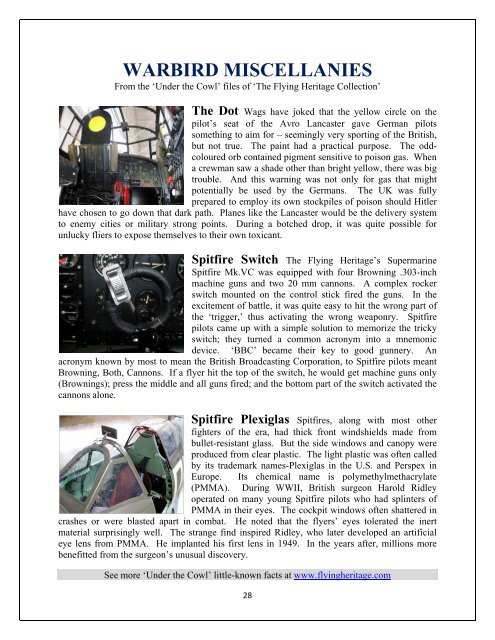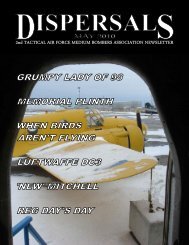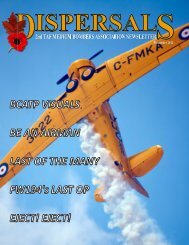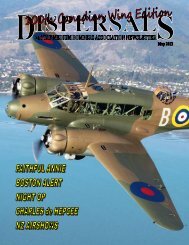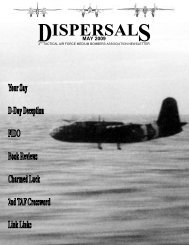November 2009 - Brussels Air Museum Foundation
November 2009 - Brussels Air Museum Foundation
November 2009 - Brussels Air Museum Foundation
You also want an ePaper? Increase the reach of your titles
YUMPU automatically turns print PDFs into web optimized ePapers that Google loves.
WARBIRD MISCELLANIES<br />
From the ‘Under the Cowl’ files of ‘The Flying Heritage Collection’<br />
The Dot Wags have joked that the yellow circle on the<br />
pilot’s seat of the Avro Lancaster gave German pilots<br />
something to aim for – seemingly very sporting of the British,<br />
but not true. The paint had a practical purpose. The oddcoloured<br />
orb contained pigment sensitive to poison gas. When<br />
a crewman saw a shade other than bright yellow, there was big<br />
trouble. And this warning was not only for gas that might<br />
potentially be used by the Germans. The UK was fully<br />
prepared to employ its own stockpiles of poison should Hitler<br />
have chosen to go down that dark path. Planes like the Lancaster would be the delivery system<br />
to enemy cities or military strong points. During a botched drop, it was quite possible for<br />
unlucky fliers to expose themselves to their own toxicant.<br />
Spitfire Switch The Flying Heritage’s Supermarine<br />
Spitfire Mk.VC was equipped with four Browning .303-inch<br />
machine guns and two 20 mm cannons. A complex rocker<br />
switch mounted on the control stick fired the guns. In the<br />
excitement of battle, it was quite easy to hit the wrong part of<br />
the ‘trigger,’ thus activating the wrong weaponry. Spitfire<br />
pilots came up with a simple solution to memorize the tricky<br />
switch; they turned a common acronym into a mnemonic<br />
device. ‘BBC’ became their key to good gunnery. An<br />
acronym known by most to mean the British Broadcasting Corporation, to Spitfire pilots meant<br />
Browning, Both, Cannons. If a flyer hit the top of the switch, he would get machine guns only<br />
(Brownings); press the middle and all guns fired; and the bottom part of the switch activated the<br />
cannons alone.<br />
Spitfire Plexiglas Spitfires, along with most other<br />
fighters of the era, had thick front windshields made from<br />
bullet-resistant glass. But the side windows and canopy were<br />
produced from clear plastic. The light plastic was often called<br />
by its trademark names-Plexiglas in the U.S. and Perspex in<br />
Europe. Its chemical name is polymethylmethacrylate<br />
(PMMA). During WWII, British surgeon Harold Ridley<br />
operated on many young Spitfire pilots who had splinters of<br />
PMMA in their eyes. The cockpit windows often shattered in<br />
crashes or were blasted apart in combat. He noted that the flyers’ eyes tolerated the inert<br />
material surprisingly well. The strange find inspired Ridley, who later developed an artificial<br />
eye lens from PMMA. He implanted his first lens in 1949. In the years after, millions more<br />
benefitted from the surgeon’s unusual discovery.<br />
See more ‘Under the Cowl’ little-known facts at www.flyingheritage.com<br />
28


